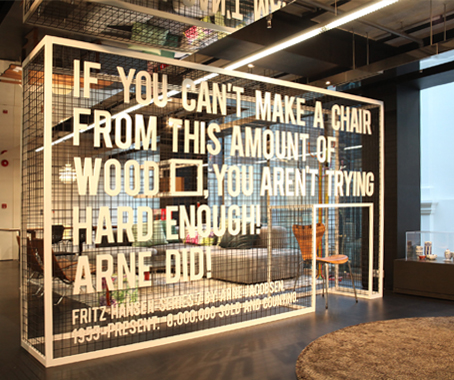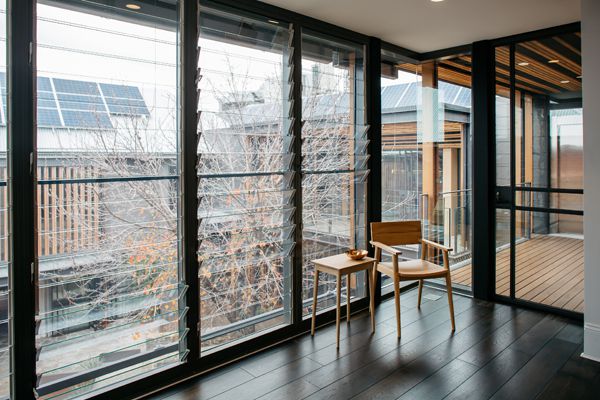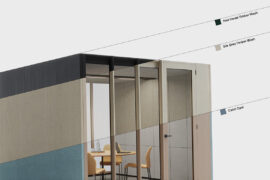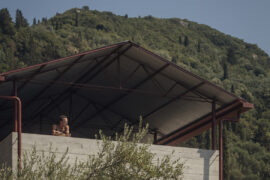Syddal Wee, Space’s general manager for Asia, talks to Janice Seow about the company’s eco steps.

May 3rd, 2012
Last month, Space held its second Green Space programme (see our story here), an initiative focussed on helping customers make more informed, sustainable decisions when it comes to furniture purchase.
On show were 5 installations by 5 design teams; each work was made using a pre-selected sustainable product from Space. For 2 days, people could also walk into the showroom to adopt a plant, with all proceeds going to WWF Singapore.


Installation by Takenouchi Webb using the Emeco Navy Chair
Syddal Wee, general manager for Space Asia, explains what triggered the idea for this initiative. “We’ve deliberately taken this position of not diluting what we sell… virtually everything is made in Europe. There are little pockets of possible exceptions in that their components could be made in Asia but shipped back to Europe to put together. But the key aspects of what we’re sharing with the consumer… [for] one is the fact that material usage is pre-selected in the sense that we do not use ecologically incorrect materials.”


Installation by Hjgher using the Flos Kelvin LED light
“In the context of Europe, when Vitra makes desktops for the office [for example], the edging is not with PVC. Over here the typical finish that is cost effective – a nice way of saying cheap – is PVC T-moulding, but that’s now not used by ecologically responsible companies. They use ABS edging, which is an ecologically-friendly material.
“Then for woodworking products they meet what is known as the E1 standard – [which measures] the emission of formaldehyde in the use of glues. The standard has now been raised to E.05, so that’s how particular the first world countries that are environmentally conscious [have become].”


Installation by Peter Tay using the B&B Italia Husk chair
Another aspect of sustainability that Space hopes to highlight through its Green Space programme, says Syddal, is ‘waste management’. “You don’t throw by-products of the process into the river. This is happening in third world countries where you see all these pollutants affecting the environment and ultimately affecting the health of the citizens.
“I think it’s almost like a zero sum game. [When] you buy something cheap [that’s] manufactured in a third world country, the cost is not paid for by the consumer, but at some point in time the citizens of the country pay for it.”

Installation by Ministry of Design using the Fritz Hansen Series 7 chair
Syddal says these steps Space is taking may be small, but every effort adds up and educating consumers about where their furniture comes from is important. “We’re also sharing this to tell consumers that just because our prices are high it doesn’t mean we make a lot of money. We do make a reasonable retail margin but it costs more, therefore you’ve to pay more for all these reasons.
“This is a luxury for people with first world income. And we’re very first world. We are considered to be one of the richest per capita countries in the world. So shouldn’t the consumer in Singapore not embrace this value enthusiastically, if not wholeheartedly?



Installation by Studio Terre using the Wishbone chair
And do all brands carried at Space carry the same sustainable focus? “All the brands at Space are made to last,” says Syddal. “I think part of the sustainable angle includes the fact that the designs have stood the test of time.”

Syddal Wee, General Manager of Space Asia
Space
spacefurniture.com.sg
INDESIGN is on instagram
Follow @indesignlive
A searchable and comprehensive guide for specifying leading products and their suppliers
Keep up to date with the latest and greatest from our industry BFF's!

Welcomed to the Australian design scene in 2024, Kokuyo is set to redefine collaboration, bringing its unique blend of colour and function to individuals and corporations, designed to be used Any Way!

For Aidan Mawhinney, the secret ingredient to Living Edge’s success “comes down to people, product and place.” As the brand celebrates a significant 25-year milestone, it’s that commitment to authentic, sustainable design – and the people behind it all – that continues to anchor its legacy.

An historic Adelaide mansion has undergone a multi-million-dollar metamorphosis that has transformed the heritage-listed 19th century pile into a 21st century landmark.

The most memorable of hospitality spaces – and it all starts with the flooring. We review the interiors of CAON and ACME’s Margaret restaurant, and DesignNu’s Rydges hotel in the Gold Coast Airport.
The internet never sleeps! Here's the stuff you might have missed

A new online space offers designers enhanced tools, resources and real-time customisation.

Dr Piers Taylor – award-winning British architect, BBC presenter and founder of Invisible Studio – returns to Australia to deliver a keynote at the inaugural Glenn Murcutt Symposium.